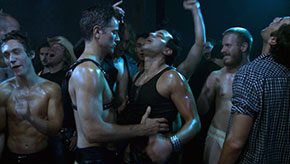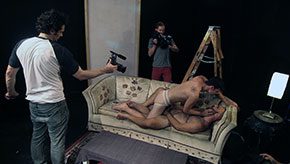The purported premise of Interior. Leather Bar., a collaboration between filmmaker Travis Mathews and James Franco, is to reimagine the forty minutes that were cut from the 1980 film Cruising, starring Al Pacino (cut in order for it to avoid an X rating). The footage, which became permanently lost, was cut due to the fact that it took place in a gay leather bar. In the film, directed by William Freidkin, Pacino plays a cop who goes undercover in search of a serial killer who has been targeting gay men at S&M clubs in NYC’s Meatpacking district.
But that’s what Interior. Leather Bar. “says it’s about”—it’s actually less a tribute to that lost footage, and more of a docufiction about the nature of sexuality, heteronormativity, and the representation of both in mainstream films. It’s also an exploration of the limits of an actor.
Franco’s investment in the film stems from his academic-tinged abhorrence of the prevalence of heteronormativity, particularly in film. His sleepy-eyed delivery sometimes masks the profundity of his mission. If you’re busy being distracted by his face, it’s easy to miss what he’s after. In one of the film’s early scenes, he’s lounging at Chateau Marmont, citing Michael Warner’s The Trouble with Normal: Sex, Politics, and the Ethics of Queer Life, a book that discusses the problem of striving for “normalcy” (aka: marriage) in the context of the gay rights movement. Say what you will about Franco’s over-extended production of various art, he’s engaged with some serious subject matter. It’s not your everyday Hollywood actor who’s lounging around reading queer theory.
When the topic comes up, Mathews, bonafide provocateur queer filmmaker, weighs in on the subject with some actual personal perspective on the matter: “There’s a fear that the hunger and the race for things like gay marriage and assimilation into straight culture is erasing all the radicalness and queerness of that world.”
That sets the stage for a very interesting dichotomy on the set of their film. When the actors arrive, most of them have no idea what the film is about. Many of them are straight men, playing gay characters for the first time, and many are gay actors having to engage with straight men confronting their straightness for the first time. This all makes for an alchemic mix of awkwardness and growth.
 The main character (if there is one of this film) is actor Val Lauren, a longtime friend of Franco’s, who has been roped into this project, somewhat against his will. Lauren is supposed to be playing the “Pacino character” (poor Lauren—his favorite actor is Pacino), but really he’s playing himself. He is highly hetero—and compulsively watchable, as his countenance oscillates between that of a sitting duck and a deer in the headlights. Lauren smokes American Spirits like they have the answers, and while he’s a “serious actor,” one gets the irrefutable sense that he’s more than nervous to play a gay man (despite the fact that he starred in the biopic about Sal Mineo.) It’s not the homosexuality that he’s squeamish about, it’s the actual sex that’s going to be happening on set.
The main character (if there is one of this film) is actor Val Lauren, a longtime friend of Franco’s, who has been roped into this project, somewhat against his will. Lauren is supposed to be playing the “Pacino character” (poor Lauren—his favorite actor is Pacino), but really he’s playing himself. He is highly hetero—and compulsively watchable, as his countenance oscillates between that of a sitting duck and a deer in the headlights. Lauren smokes American Spirits like they have the answers, and while he’s a “serious actor,” one gets the irrefutable sense that he’s more than nervous to play a gay man (despite the fact that he starred in the biopic about Sal Mineo.) It’s not the homosexuality that he’s squeamish about, it’s the actual sex that’s going to be happening on set.
On the day of the shoot, Franco and Mathews corral the men into a dodgy warehouse, where the costuming is mostly leather, and the S&M club from Cruising is recreated. The audience knows that we’re going to witness some graphic sex, but that’s not the exciting part of the film. The bulk of the film’s interest comes in all the steamy meta-talk that happens when the camera is working behind the scenes: gay and straight men having conversations about what it means to make this film, what it means to be an actor, what it means to confront their own respective heteronormativity and homonormativity.
When Lauren’s asked about how he feels shooting Interior. Leather Bar., his answer: “I don’t personally like this project. What I do respond to, and always have, is James’s mission. I don’t always understand it, but I like it, what he’s doing, even when I don’t understand it. My question is: Is this something that we, as the artists working on it, are going to manipulate it to make a certain point, or do you want it to just be what it is?”
That question goes permanently and appropriately unanswered.
It doesn’t help that Lauren’s agent (possibly staged, hard to tell), calls him on the phone with more than doubt: “I know you’re at the Franco faggot project today, and I gotta tell you, man, I don’t know where your head is on this, and I really think we need to talk about this right away…”
More smoking, more scrunched tense perturbed faces from Lauren.
Back on set, Mathews is directing two men on a sex scene, saying, “You’re basically going to submit to what he wants”—which turns out to be an apt analogy for the relationship between Franco and Lauren as well.
Lauren is on the set because Franco is on the set, and one of the film’s best scenes comes as a conversation the two old friends have.
Franco begins, and he’s clearly worked up. “I don’t like realizing that my mind has been twisted by the way that the world has been set up around me,” he says. “And what that is, is straight-normative kind of behavior, and it’s fucking instilled into my brain. If there’s a way for me to break that up in my own mind, I’m all for it. I think that’s why you want to be an actor and an artist.”
Lauren: “You think that this [sex] should be in movies, and people should be able to see it?”
Franco: “Yes! Fuck yes! Sex should be a storytelling tool, but we’re so fucking scared of it. Everybody talks about sex but then don’t dare put it in a movie!…Or you’re allowed to talk about it in certain ways, like locker-room humor or frat-house humor, but don’t show gay sex. That’s the fucking devil. In previews, show people getting fucking blown away and killed, but don’t show gay sex.”
Lauren: “They do show gay sex in X-rated theaters.”
Franco: “Yeah! Put it in the fucking mainstream!
Lauren: “Why?”
Franco: “To help tell stories! It’s a great tool. It’s who we are. Everybody has sex. Everybody thinks about sex all the fucking time. We can’t fucking put it in movies? We can put people killing each other, strangling each other, murdering each other.”
Lauren: “There’s sex in movies everywhere.”
Franco: “Yeah in a certain way. It’s fetishized.”
Lauren: “Yeah, turned into something a little more tame for people, more palatable.”
Franco: “Why don’t they give us violence in a more palatable way, then amp up the sex? That’s what I say.”
Most of the movie is this behind-the-making-of meta investigation. When the actual “reimagined” footage of the “Pacino-character” pretending to cruise in the bar is shot, the viewer’s eyes slither around, and when the camera focuses on Lauren, you see that he gets the discomfort of the character dead on. He could not seem more uncomfortable, and one has to wonder how much acting he’s doing, and how much is just the real Val Lauren facing his own programmed fears around masculinity and sexuality. It’s a beautiful and highly intelligent examination of the art of acting.
Lauren, back on the phone with his “agent”: “I’m here on set. Dicks are out. Balls are out. People are paddling each other on the ass. There’s bruises. There’s fucking welts. Sucking. Fucking. Armpits. Balls. Assholes. Everything’s out dude.”
 And it’s true. Everything he says is in the film. Luckily, the viewer gets treated to Mathews’ signature intimate style of filming sex scenes. There isn’t a single queer filmmaker out there who gets the intimate nature of gay male sex the way Mathews does. And while Lauren looks on—he actually twitches at one point—you know that he walks away from the project more open-minded than when he arrived.
And it’s true. Everything he says is in the film. Luckily, the viewer gets treated to Mathews’ signature intimate style of filming sex scenes. There isn’t a single queer filmmaker out there who gets the intimate nature of gay male sex the way Mathews does. And while Lauren looks on—he actually twitches at one point—you know that he walks away from the project more open-minded than when he arrived.
This is also a great film for those interested in Franco as an artist and as a cultural subject; he’s got quite the catholic (yes, small c) appetite for the world, and it’s fun to watch his insatiability on set. What he’s interested in is examining the production of art, the questions behind it, and the limits of his own self, artistic and otherwise. It would appear that he’s really up for anything. I mean, the fact that he’s making a Disney movie at the same time he’s filming sex scenes for Interior. Leather Bar. speaks volumes about his range and interests. There’s a lot of people out there who bag on Franco (to them I ask, “What the hell have you guys done lately?”), but he’s an admirable role model for artists, prolific and willing to explore the edge.
Additionally, Interior. Leather Bar. highlights a turning point for “new queer cinema,” a term coined by B. Ruby Rich in 1992, that originally often described films that rejected notions of heteronormativity. With the shift in the gay rights movement, one has to wonder how that term has evolved. Mathews seems to be suggesting that queer film is cresting toward being normalized, and that the notion of a “new queer cinema” is now up for debate.
While Interior. Leather Bar. may be a petite film lengthwise (60 minutes), its girth is not shy. This is some heavy-hitting stuff. It takes a long and hard look at all the things everyone else has been too afraid to examine. Mathews is a filmmaker to watch, mostly because he changes the way we see.





